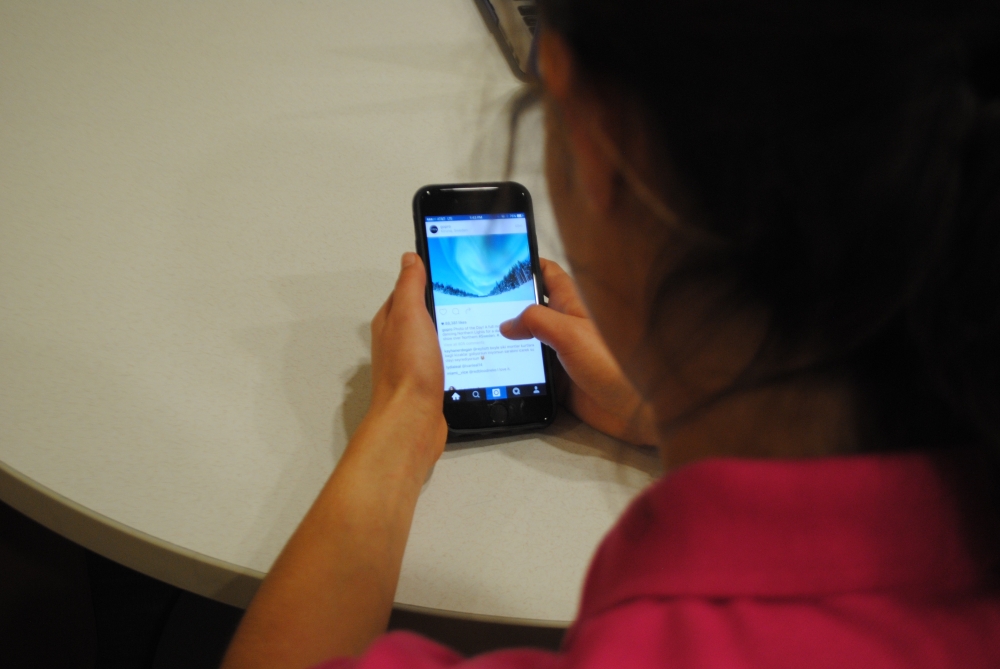[ot-caption title=”With there being over 150 million Instagram users between 16-24, FOMO may leave its mark on the impressionable young generation. (via, Jack Steinberg/Junior)”]
Scroll…scroll…pause…double tap…repeat. Sounds sort of like a game…well, it kind of is, including the elements of elation and defeat. This finger tapping obsession is Instagram, the mobile app that brings photos to life from all around the world. Its slogan, “Capture and share the world’s moments” connects to people. Just the thought of that phrase sounds beautiful: “the world’s moments,” …if only these “moments” didn’t have upsetting consequences. Created in 2010, the mobile social network brought a modern edge to its precursor, Facebook. [spacer height=”10px” id=”2″]
As of November 2015, Instagram had 400 million users, and 41% of those users are between the ages of 16-24. It is estimated that in 2018, there will be about 106.2 million users. Over the last six years, Instagram has connected users from all over the world and enabled them to share the joy and excitement happening in their everyday lives. [spacer height=”10px” id=”2″]
These aspects sound great, so where’s the catch? Well, as user numbers keep increasing, so will the amount of universal FOMO. What is FOMO? An increasingly popular term of the millennial generation, FOMO, stands for “fear of missing out.” FOMO is that little voice in your head or pang in your stomach signaling feelings of exclusion, sadness, disappointment, etc. This modern case of anxiety isn’t just caused by Instagram; users of Facebook, Snapchat, and other modes of social media are also guilty of fueling the fire of FOMO. Social media FOMO triggers include everything from a photo of a night out you were not at to posts about the fabulous restaurant your friends ate at last weekend. “Fear of missing out” is also prevalent when it comes to making or fulfilling social plans; people with serious cases of FOMO typically struggle with commitments because of anxiety that something better will be available after it’s too late. [spacer height=”10px” id=”2″]
No matter how hard people try to suppress certain feelings, this branch of anxiety can’t be blocked out. FOMO is a universal feeling that is common throughout the human race. MIT Professor Sherry Turkle shares in her book Alone Together that technology has the power to control not only relationships, but also peoples’ self control of moods and emotions. So, just as feelings of sadness or anger emerge without warning, FOMO finds a way to creep into most people’s lives as well. However, it is only as severe as the recipient allows it to be; it comes in all shapes and sizes, depending on the self-esteem and mindset of the person. [spacer height=”10px” id=”2″]
FOMO has existed ever since the creation of newspapers, magazines, television, etc. that depict the glamorous lifestyles that most people envy. With the emergence of the Internet, the 21st century social media craze has allowed FOMO to take on a new form. People are no longer just intrigued by celebrities, but they are now envious of their friends, too. [spacer height=”10px” id=”2″]
Excessive FOMO leads adolescents to feel bad about themselves and plays on self-esteem. Pine Crest sophomore Caroline Adkins explains her thoughts. “I think to some degree, it kind of contributes to insecurities with people because they are afraid that people don’t like them based on if someone likes their picture.” Senior Tori Engler shares her own personal thoughts about the FOMO epidemic. “(FOMO) doesn’t make me feel good. It makes me feel unwanted, like I wasn’t part of something.” With the overwhelming need to be socially “in the know,” Tori and millions of teenagers continue to use Twitter, Facebook, and Snapchat, despite the often inevitable FOMO that results. [spacer height=”10px” id=”2″]
Often the victims of FOMO are the villains of FOMO. Teenagers are by nature narcissistic; posting photos of their good time on Friday and then being hurt by a friend’s post on Saturday seems to be extraordinarily hypocritical. People get so wrapped up in the excitement of getting likes and shares on social media that they forget about offending a friend. Sophomore Jordan Moldow states that he tries to be thoughtful when posting. “Thinking about someone else, if we know someone is not going [to a party], we try not to post too much on social media because we don’t want to make them feel bad that they couldn’t go.” [spacer height=”10px” id=”2″]
In contrast, other users think it is perfectly fine to share with their peers the awesome sandwich they just ate or even the great time they had out with friends. Senior Sabrina Gornisiewicz and Junior Marta Ciesla share that it is okay to post photos with friends while not feeling bad; Sabrina states, “I think you have the right to be mad for two seconds and then get over it.” Marta adds, “Also, if you’re super close with the friend that you’re with, and you’re not as close with the friend that is mad, I don’t think that is something to get mad about.” [spacer height=”10px” id=”2″]
In agreement with Sabrina and Marta, some students enjoy seeing what their peers are up to, whether it is over vacation, a weekend, or even after school. PC junior Noah Stollman expresses his positive take on social media. “I like to see my friends having fun and enjoying themselves, and I don’t get upset if someone doesn’t invite me to something. [When I see friends’ posts], I get to find good places to go and have good conversations with them about their fun time.” [spacer height=”10px” id=”2″]
Despite its pitfalls, social media is definitely here to stay. High school and college students should be cognizant that they are not alone. They should remember that they are not the only people who feel FOMO, and that it is normal and natural when the wave of social anxiety hits. So keep in mind your peers’ feelings before hitting “upload” if you don’t want to potentially feel the same exclusion in return. Now, let’s break the vicious FOMO cycle and prevent the hash tag #FOMO from taking over the new year. [spacer height=”20px”]
Sources: Digital Trends, Digital Statistics, Psychology Today, NY Times, Mashable, Odyssey
































![Stranger Things 4: What to Expect [Warning: Contains Spoilers]](https://pcpawprint.com/wp-content/uploads/2021/11/StrangerThings4-900x473.jpeg)























































